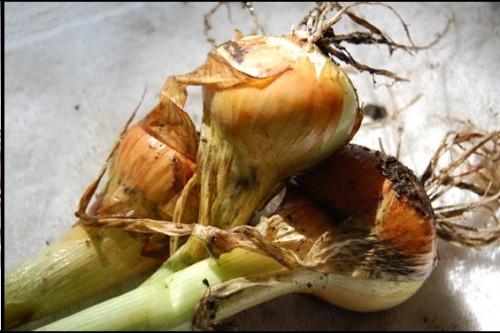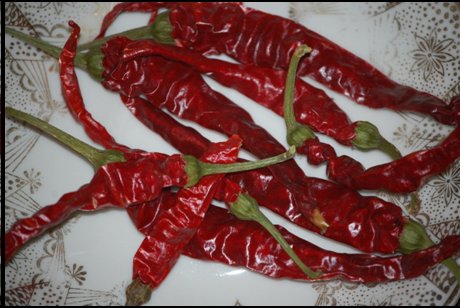Since much of the great foods I know about contain this famous trinity, I’ll mention them first. As a base for great sauces, roux or as a general flavoring, the onion, bell pepper and celery add depth and richness to anything they touch.
Onions
Onions are wonderfully useful and handy to have in dehydrated form. I always smile as I recall the first time I dried onions. After preparing a large batch, I set the thermostat and timer and went to bed. Overnight the dehydrating ran hour upon hour and our house smelled faintly of onions when we awoke. Oh, if it were only so! Our house smelled decidedly like an onion farm…only indoors. Honestly, I thought it was wonderful although no one else shared that opinion. My family begged me not to dry onions inside the house ever again. After discussing it amongst themselves, they quickly changed the begging to a simple demand. Onions were to be dried outdoors! So consider yourselves warned: onions smell strong, even when dehydrating. Did it stop me? Slow me down? Never! Onions are too useful and easy to dehydrate. You always have the option of drying odiferous foods in a garage or enclosed porch…to keep the peace in the family.
You can slice or chop the onions depending on how you choose to use them. You can also pulverize them after drying to make your own onion powder. Chances are good you have many forms of dehydrated onions in your home already. Why not create your own onion soup mix, onion- powder and personally designed herb blends?
If you want slices, after removing the skin, slice ¼” thick. Separate the rings and place on racks. Smaller rings can be put inside of larger ones to save space. Overlapping the rings will increase necessary drying time. If you chop onions (my personal favorite), keep the slices between ¼” and ½” cubed. I prefer chopped onions since they‘re so versatile.
Dry onions at 130 degrees for approximately eight hours. You’ll know they are done when it is obvious they have no moisture left in them. They will be crispy and brittle. Drying time always varies since humidity affects how quickly things dry. You can pull trays out and stir them around. This assures the warmed air is reaching all of the cut sides. Be sure to check them periodically and store in an air-tight jar or bag if you’re drying larger quantities.
Peppers
Another great staple among your supplies are peppers…any variety will do. The culinary trinity refers to bell peppers but dehydrating is the same whether spicy or sweet. Enjoy all the choices available. Some of our favorites are banana, jalapeno and cayenne peppers. Your garden or your neighbor’s might be teeming with peppers. What are you to do with such an abundant supply? Dehydrate, of course!
Wash and slice peppers ¼” thick. When I’m cutting up bell peppers (green, red or yellow), I slice half and chop the other half. That way I end up with a useful mix for cooking. When working with hot peppers, use gloves or wash your hands thoroughly after handling them.
Use the rings you’ve dried in a pot of chili or rehydrate and add to pizza. I always dry the cayenne peppers I get from our garden and grind them into a powder to use in my cooking. The health benefits of peppers are numerous.
Some dehydrated foods change their appearance drastically during the drying process but peppers don’t change much except for normal shrinkage. The beautiful colors of the dried peppers warm your kitchen as much as the spice of the peppers warms your meals.
Wash and slice bell peppers ¼” thick then remove the seeds and place on a drying rack. With spicy peppers that I intend to pulverize, I often leave the seeds to dry with the flesh of the pepper since they add heat to the powder. Dry at 130 degrees for twelve to eighteen hours. The peppers shouldn’t have any sign of moisture when completely dried. If you want to use as a powder, place the peppers in a blender or food processor and pulse until completed. Store in an air-tight jar.
Celery
I love having dried celery on hand. Easy to buy, inexpensive and available year-round, celery is a great food to dry. Added to soups and stews, it rehydrates perfectly while cooking.
I’ve found myself composting celery that was purchased with good intentions and forgotten. (At least it ended up in Compost Heaven.) I’ve also had whole celery freeze and convinced it is no longer useful, I’ve thrown it out. But I hate waste. Now days, if a package of celery should freeze, I’m not the least upset. I simply prep it for drying and add to my stash. I need only run out and buy more if I’m planning to eat raw celery.
Wash and cut into ¼” slices. Blanch celery in a pot of boiling water for one minute then immediately put the celery into a bowl of cold water. Drain well and add to the drying trays. Since celery shrinks as it dries, you may want to put a sheet of parchment paper (or a non-stick sheet) under the celery so it doesn’t fall through the racks. Set the temperature on your dehydrator to 130 degrees and dry for four to eight hours. Check periodically for crispness.
After drying, celery can be ground into powder and used as a salt-substitute since it has a high-sodium content. Plan to use it when making designer spices.
About Jan Nellis
Jan Nellis is a happily married mom of five children, three of whom are still at home. She spends her free time rediscovering the lost domestic arts with an emphasis on health issues. An avid quilter, crocheter, hand-spinner and cook, her desire is to rekindle the ways of her grandmothers, blessing her friends and family. She has spoken at women’s groups on forgiveness, following God's plan for your life and the joys of living with God. She currently blogs at www.atinylittleripple.blogspot.com.





